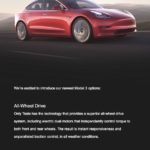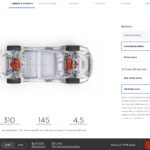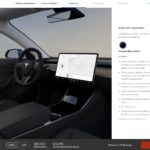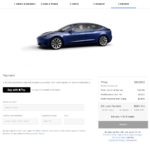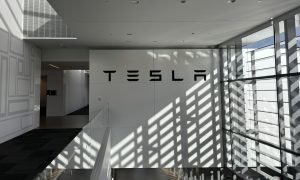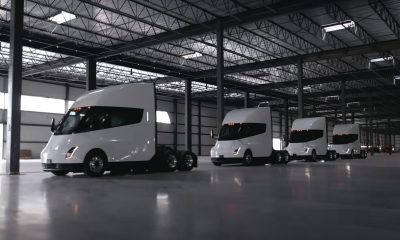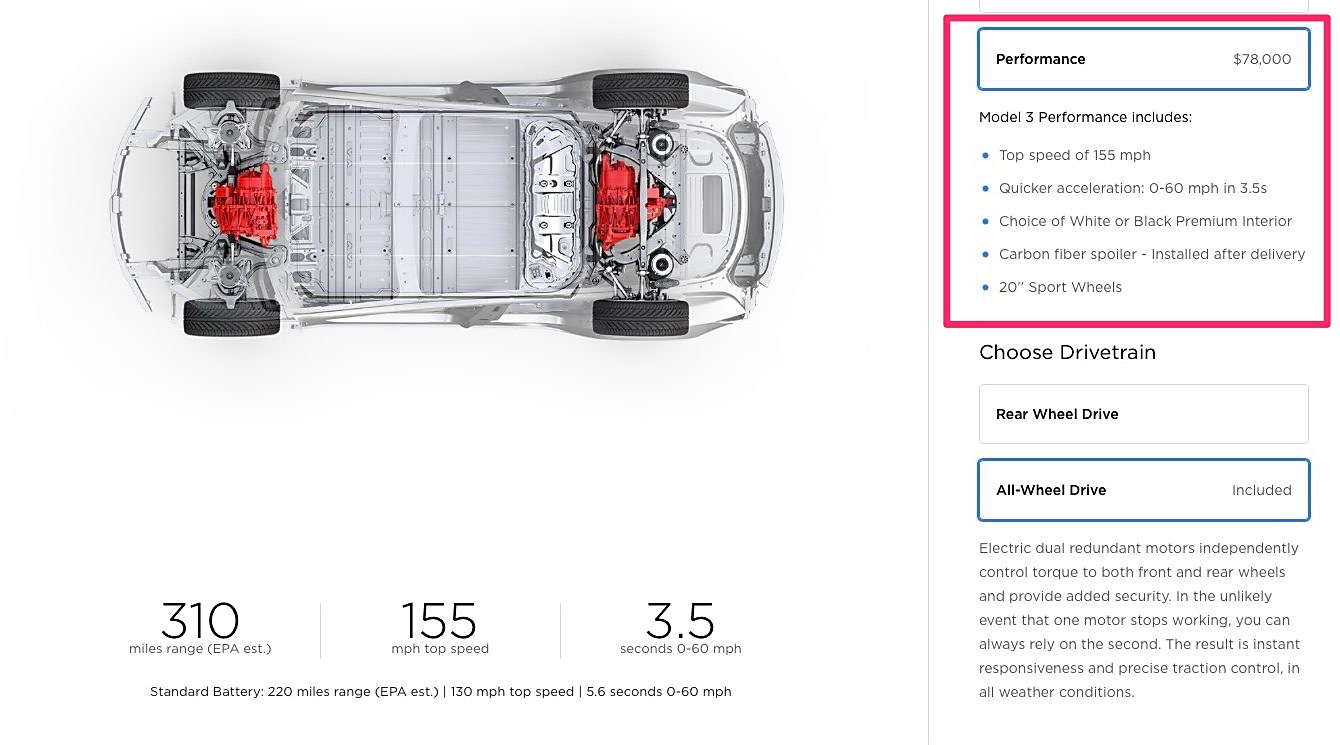

News
Tesla invites new batch of Model 3 buyers to configure AWD Performance version
With orders for Tesla Model 3 in a dual motor configuration now open, the electric car maker has started inviting batches of reservation holders to configure their AWD and Performance Model 3.
As could be seen in the updated Model 3 online configurator, the dual motor AWD and Performance option has been included, and together add $29,000 over the $49,000 Long Range Model 3 RWD pricing without Autopilot. Choosing Performance automatically selects the dual motor drivetrain, while the rest of the Model 3 Design Studio screens, from the paint color and wheels to the interior and Autopilot, remain unchanged.
- The Model 3 AWD and Performance email invitation. [Credit: @Teslaliving via Twitter]
- The Model 3 AWD and Performance configuration screen. [Credit: @Teslaliving via Twitter]
- The Model 3 AWD and Performance configuration screen. [Credit: @Teslaliving via Twitter]
- The Model 3 AWD and Performance configuration screen. [Credit: @Teslaliving via Twitter]
- The Model 3 AWD and Performance configuration screen. [Credit: @Teslaliving via Twitter]
- The Model 3 AWD and Performance configuration screen. [Credit: @Teslaliving via Twitter]
Photo credit: @Teslaliving via Twitter
The two new Model 3 variants are designed for better all-weather traction and overall performance. The dual-motor AWD upgrade, for example, improves the Model 3’s 0-60 mph time to 4.5 seconds, more than half a second faster than the rated 0-60 time of the long-range RWD variant, which is listed at 5.1 seconds. As noted by Elon Musk on Twitter, and as could be seen in the configuration screen of the vehicle, selecting the dual motor upgrade will add $5,000 to the price of the single motor Long Range Model 3 and bring its base price up to $54,000 from $49,000.
At $78,000, the Model 3 Performance package offers customers a 0-60 mph time of 3.5 seconds and a top speed of 155 mph. Buyers can also select between a Black or White Premium interior, a carbon fiber rear spoiler that will be installed after delivery, and 20-inch Sport Wheels. Both the dual motor and Performance Model 3 are expected to begin production sometime in July, when the Model 3 line achieves a steady rate of 5,000 vehicles per week.

The Model 3 AWD and Performance configuration screen. [Credit: @Teslaliving via Twitter]
Tesla is steadily showing signs that it is starting to hit its stride with the production of the Model 3. Just yesterday, reports emerged that the electric car maker has filed 7,237 new Model 3 VINs, its single, largest batch to date. With the latest filings, Tesla has registered a total of 51,669 Model 3 VINs since the company started manufacturing the electric car mid-2017.
Tesla’s registrations for the Model 3 have reached new levels this month. Since April’s end, Tesla has registered a total of 17,950 new Model 3 vehicle identification numbers, a feat that took Tesla months to accomplish before. The company, for example, only broke the 17k VIN barrier last March 23.
By sending out invites to configure the dual-motor AWD and Performance Model 3, it appears that Tesla, since starting the production of the compact electric car, is finally confident that it can deliver the electric car on its estimated timeline.
Tesla is currently aiming to hit a production rate of 5,000 Model 3 per week by the end of Q2 2018. Following a scheduled shutdown late this month, Tesla expects the Model 3 line to have a production capacity of 5,000-6,000 vehicles per week.
News
Tesla begins Robotaxi certification push in Arizona: report
Tesla seems serious about expanding its Robotaxi service to several states in the coming months.

Tesla has initiated discussions with Arizona transportation regulators to certify its driverless Robotaxi service in the state, as per a recent report from Bloomberg News. The move follows Tesla’s launch of its Robotaxi pilot program in Austin, Texas, as well as CEO Elon Musk’s recent comments about the service’s expansion in the Bay Area.
The Arizona Department of Transportation confirmed to Bloomberg that Tesla has reached out to begin the certification process for autonomous ride-sharing operations in the state. While details remain limited, the outreach suggests that Tesla is serious about expanding its driverless Robotaxi service to several territories in the coming months.
The Arizona development comes as Tesla prepares to expand its service area in Austin this weekend, as per CEO Elon Musk in a post on X. Musk also stated that Tesla is targeting the San Francisco Bay Area as its next major market, with a potential launch “in a month or two,” pending regulatory approvals.
Tesla first launched its autonomous ride-hailing program on June 22 in Austin with a small fleet of Model Y vehicles, accompanied by a Tesla employee in the passenger seat to monitor safety. While still classified as a test, Musk has said the program will expand to about 1,000 vehicles in the coming months. Tesla will later upgrade its Robotaxi fleet with the Cyercab, a two-seater that is designed without a steering wheel.
Sightings of Cybercab castings around the Giga Texas complex suggests that Tesla may be ramping the initial trial production of the self-driving two-seater. Tesla, for its part, has noted in the past that volume production of the Cybercab is expected to start sometime next year.
In California, Tesla has already applied for a transportation charter-party carrier permit from the state’s Public Utilities Commission. The company is reportedly taking a phased approach to operating in California, with the Robotaxi service starting with pre-arranged rides for employees in vehicles with safety drivers.
News
Tesla sets November 6 date for 2025 Annual Shareholder Meeting
The automaker announced the date on Thursday in a Form 8-K.

Tesla has scheduled its 2025 annual shareholder meeting for November 6, addressing investor concerns that the company was nearing a legal deadline to hold the event.
The automaker announced the date on Thursday in a Form 8-K submitted to the United States Securities and Exchange Commission (SEC). The company also listed a new proposal submission deadline of July 31 for items to be included in the proxy statement.
Tesla’s announcement followed calls from a group of 27 shareholders, including the leaders of large public pension funds, which urged Tesla’s board to formally set the meeting date, as noted in a report from The Wall Street Journal.
The group noted that under Texas law, where Tesla is now incorporated, companies must hold annual meetings within 13 months of the last one if requested by shareholders. Tesla’s previous annual shareholder meeting was held on June 13, 2024, which placed the July 13 deadline in focus.
Tesla originally stated in its 2024 annual report that it would file its proxy statement by the end of April. However, an amended filing on April 30 indicated that the Board of Directors had not yet finalized a meeting date, at least at the time.
The April filing also confirmed that Tesla’s board had formed a special committee to evaluate certain matters related to CEO Elon Musk’s compensation plan. Musk’s CEO performance award remains at the center of a lengthy legal dispute in Delaware, Tesla’s former state of incorporation.
Due to the aftermath of Musk’s legal dispute about his compensation plan in Delaware, he has not been paid for his work at Tesla for several years. Musk, for his part, has noted that he is more concerned about his voting stake in Tesla than his actual salary.
At last year’s annual meeting, TSLA shareholders voted to reapprove Elon Musk’s compensation plan and ratified Tesla’s decision to relocate its legal domicile from Delaware to Texas.
Elon Musk
Grok coming to Tesla vehicles next week “at the latest:” Elon Musk
Grok’s rollout to Tesla vehicles is expected to begin next week at the latest.

Elon Musk announced on Thursday that Grok, the large language model developed by his startup xAI, will soon be available in Tesla vehicles. Grok’s rollout to Tesla vehicles is expected to begin next week at the latest, further deepening the ties between the two Elon Musk-led companies.
Tesla–xAI synergy
Musk confirmed the news on X shortly after livestreaming the release of Grok 4, xAI’s latest large language model. “Grok is coming to Tesla vehicles very soon. Next week at the latest,” Musk wrote in a post on social media platform X.
During the livestream, Musk and several members of the xAI team highlighted several upgrades to Grok 4’s voice capabilities and performance metrics, positioning the LLM as competitive with top-tier models from OpenAI and Google.
The in-vehicle integration of Grok marks a new chapter in Tesla’s AI development. While Tesla has long relied on in-house systems for autonomous driving and energy optimization, Grok’s integration would introduce conversational AI directly into its vehicles’ user experience. This integration could potentially improve customer interaction inside Tesla vehicles.
xAI and Tesla’s collaborative footprint
Grok’s upcoming rollout to Tesla vehicles adds to a growing business relationship between Tesla and xAI. Earlier this year, Tesla disclosed that it generated $198.3 million in revenue from commercial, consulting, and support agreements with xAI, as noted in a report from Bloomberg News. A large portion of that amount, however, came from the sale of Megapack energy storage systems to the artificial intelligence startup.
In July 2023, Musk polled X users about whether Tesla should invest $5 billion in xAI. While no formal investment has been made so far, 68% of poll participants voted yes, and Musk has since stated that the idea would be discussed with Tesla’s board.
-

 Elon Musk1 week ago
Elon Musk1 week agoTesla investors will be shocked by Jim Cramer’s latest assessment
-

 Elon Musk2 days ago
Elon Musk2 days agoElon Musk confirms Grok 4 launch on July 9 with livestream event
-

 News2 weeks ago
News2 weeks agoTesla Robotaxi’s biggest challenge seems to be this one thing
-

 Elon Musk9 hours ago
Elon Musk9 hours agoxAI launches Grok 4 with new $300/month SuperGrok Heavy subscription
-

 News6 days ago
News6 days agoTesla Model 3 ranks as the safest new car in Europe for 2025, per Euro NCAP tests
-

 Elon Musk2 weeks ago
Elon Musk2 weeks agoA Tesla just delivered itself to a customer autonomously, Elon Musk confirms
-

 Elon Musk2 weeks ago
Elon Musk2 weeks agoTesla’s Omead Afshar, known as Elon Musk’s right-hand man, leaves company: reports
-

 Elon Musk1 week ago
Elon Musk1 week agoxAI’s Memphis data center receives air permit despite community criticism

